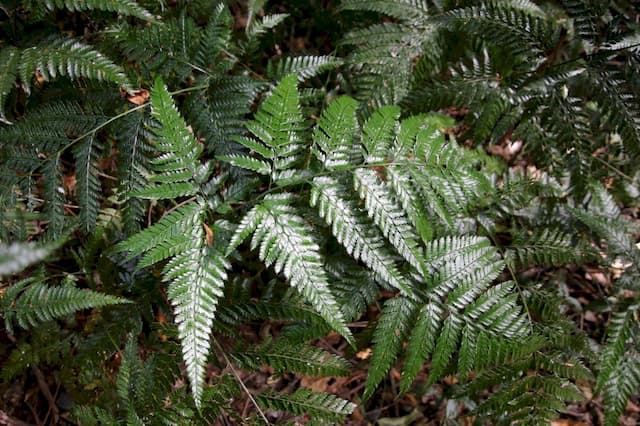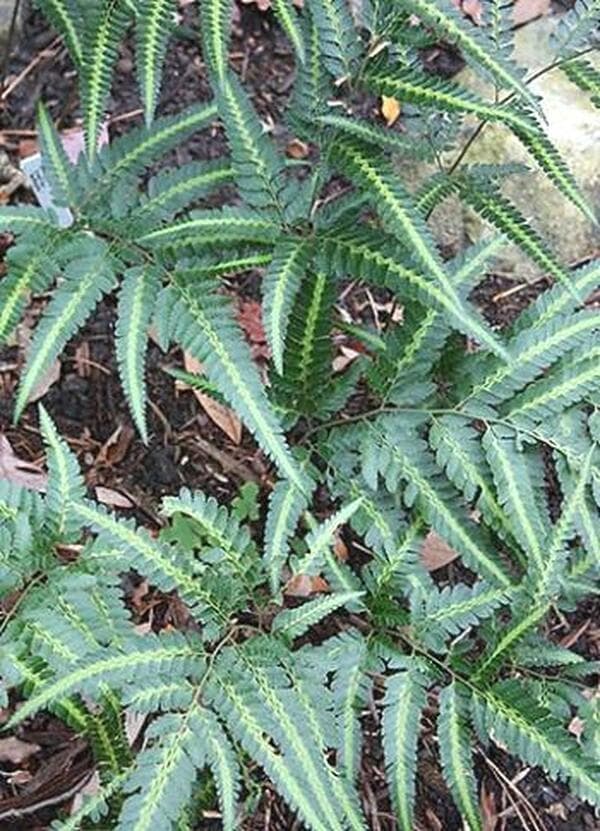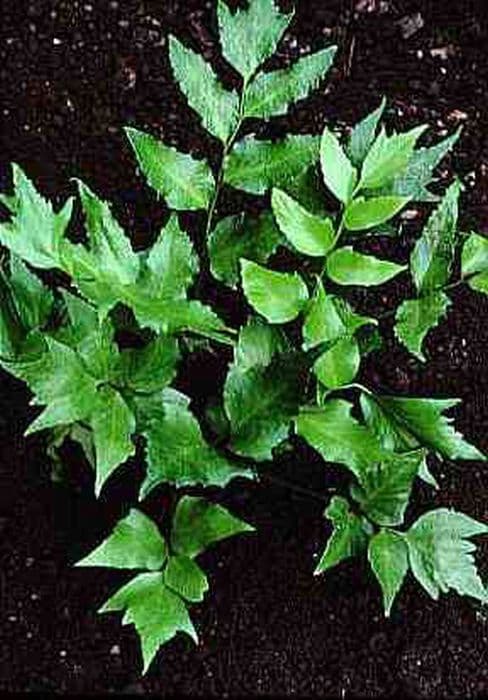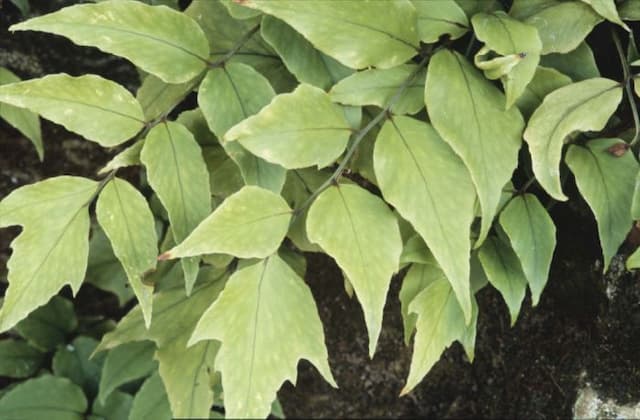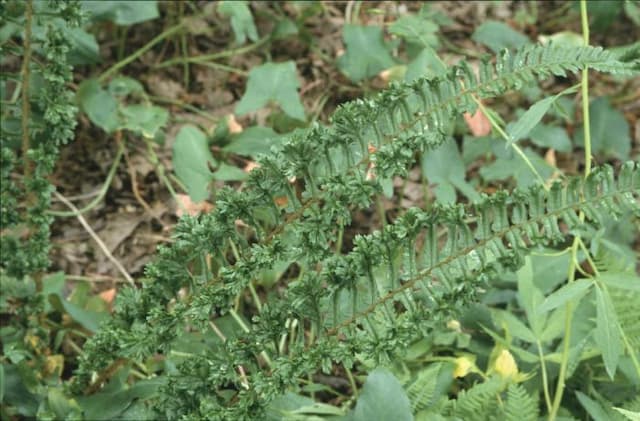Goldie's wood fern Dryopteris goldieana

ABOUT
Dryopteris goldieana, commonly known as Goldie's Wood Fern, is a perennial fern that showcases a lush and imposing appearance. This plant is characterized by its broad, deep green fronds that exhibit a classic fern structure, with numerous small leaflets that possess a leathery texture. The leaflets are typically arranged in a somewhat overlapping fashion along the stalks, creating a dense and textured look. The fronds are arching, giving the fern an elegant and spreading form. The stalks holding the leaflets are usually a paler green and may have a slightly scaly or hairy texture, adding to the plant's detailed appearance. The fern presents a dense clustering habit, with the fronds growing from a central, roughly circular crown that gives the plant a well-structured and symmetrical look. The plant bears no flowers, instead reproducing through spores that are found on the underside of the leaflets, arranged in patterns that are often covered by a thin tissue at maturity. The overall impression of Goldie's Wood Fern is that of a classic woodland plant, contributing a serene and woodsy feel wherever it grows.
About this plant
 Names
NamesSynonyms
Goldie's Wood Fern, Giant Wood Fern
Common names
Aspidium goldieanum, Dryopteris ampla, Nephrodium goldieanum.
 Toxicity
ToxicityTo humans
Goldie's fern is generally not considered toxic to humans. There are no significant toxic symptoms associated with ingesting this plant. However, as with many non-edible plants, individual allergic reactions or gastrointestinal discomfort cannot be entirely ruled out if ingested.
To pets
Goldie's fern is not known to be toxic to pets. It does not contain any known toxic principles that would pose a risk to animals if they happen to ingest it. However, as with all non-food plants, ingestion can sometimes lead to mild gastrointestinal upset due to the irritation of the stomach or intestines.
 Characteristics
CharacteristicsLife cycle
Perennials
Foliage type
Deciduous
Color of leaves
Green
Height
3 feet [91 cm]
Spread
3 feet [91 cm]
Plant type
Fern
Hardiness zones
3
Native area
North America
Benefits
 General Benefits
General Benefits- Ornamental Appeal: Dryopteris goldieana, commonly known as Goldie's wood fern, features an attractive foliage that enhances the aesthetic of gardens and landscapes.
- Shade Tolerance: This plant is highly suitable for shaded areas where other plants might struggle to grow, making it valuable for forest underplanting and shaded garden designs.
- Erosion Control: With its extensive root system, Goldie's wood fern can help stabilize soil and prevent erosion on slopes and in shaded areas.
- Habitat for Wildlife: It provides cover and habitat for various insects and animals, contributing to biodiversity.
- Low Maintenance: Once established, Goldie's wood fern requires minimal care, making it a convenient choice for gardeners looking for an easy-to-maintain plant.
- Drought Resistance: It can tolerate periods of drought once established, which is beneficial in areas with water restrictions or in xeriscaping.
- Deer Resistance: Goldie's wood fern is relatively resistant to grazing by deer, which can be particularly important in areas where deer predation is a problem.
 Medical Properties
Medical PropertiesThis plant is not used for medical purposes.
 Air-purifying Qualities
Air-purifying QualitiesThis plant is not specifically known for air purifying qualities.
 Other Uses
Other Uses- Goldie’s wood fern can be used in a terrarium or vivarium environment, providing a naturalistic backdrop and helping maintain humidity for the habitat’s residents.
- The fronds of Goldie’s wood fern can be used in floral arrangements, offering a lush, green accent to bouquets or indoor plant displays.
- Since Goldie’s wood fern can grow in relatively shady conditions, it's sometimes used in theater productions or film sets to create a backdrop that mimics a forest or woodland scene.
- The large fronds of the Goldie’s wood fern can serve as a natural mulch when they fall, helping to suppress weeds and retain soil moisture in garden beds.
- This fern's robust size makes it an ideal choice for erosion control in shaded slopes or areas prone to soil shifting.
- In artistic projects, Goldie’s wood fern may be pressed, dried, and incorporated into botanical papermaking or natural art prints.
- Goldie’s wood ferns are used to create green roofs in some applications, where they can insulate buildings and reduce the urban heat island effect.
- The dense clumps formed by Goldie’s wood fern can provide shelter and nesting sites for small animals and insects in a naturalized garden setting.
- Educationally, Goldie’s wood fern is sometimes used in classroom lessons to teach children about plant growth, reproduction, and fern life cycles.
- As a result of its substantial size, the Goldie’s wood fern can be used as a natural privacy screen in shaded garden areas or between neighboring properties.
Interesting Facts
 Feng Shui
Feng ShuiThe Goldie's fern is not used in Feng Shui practice.
 Zodiac Sign Compitability
Zodiac Sign CompitabilityThe Goldie's fern is not used in astrology practice.
 Plant Symbolism
Plant Symbolism- Resilience: As a hardy fern, Goldie's wood fern symbolizes the ability to thrive in challenging conditions.
- Endurance: The plant can survive in deep shade as well as bright areas, representing endurance through varying circumstances.
- Growth: Ferns often symbolize new growth or new beginnings, as they are one of the first plants to reappear after a forest fire or other clearing events.
- Shelter: With its large fronds, Goldie's wood fern can provide shelter to smaller plants and creatures, symbolizing protection and safety.
- Solitude: Often found growing alone or in small clusters, this fern can signify a preference for solitude or quiet independence.
 Water
WaterGoldie's wood fern should be watered deeply once a week, allowing the top inch of soil to dry out between waterings. In a typical indoor setting, this might equate to roughly half a gallon of water for a medium-sized plant, though individual needs can vary based on environmental conditions like humidity and temperature. Overwatering can lead to root rot, so it's crucial not to let the plant sit in soggy soil. During the growing season, you may need to water more frequently, while in the dormant winter months, you can reduce watering slightly.
 Light
LightGoldie's wood fern thrives in partial to full shade, making it ideal for spots where the sun is filtered through a canopy of trees or diffused by curtains indoors. Bright, indirect light is optimal as direct sunlight can scorch the fronds. It is best to avoid south-facing windows where the intense sun can be too much, and instead opt for eastern or northern exposures where the light is gentler.
 Temperature
TemperatureGoldie's wood fern prefers temperatures between 60°F and 70°F during the day and should not drop below 50°F at night. It can tolerate brief periods of colder temperatures but prolonged exposure to temperatures below 50°F can cause damage. The ideal temperature range for this fern ensures healthy growth and avoids the stress that extreme conditions can inflict.
 Pruning
PruningPruning Goldie's wood fern involves removing any brown or damaged fronds to maintain a tidy appearance and can encourage healthier growth. This pruning should be done as needed, typically in the spring before new growth starts. There's no need for extensive pruning; just a little clean-up to remove old fronds.
 Cleaning
CleaningAs needed
 Soil
SoilGoldie's woodfern thrives in moist, well-drained soil mixed with compost and leaf mold, with a slightly acidic to neutral pH of 6.0 to 7.0. A mixture containing one part garden soil, one part peat moss or coconut coir, and one part perlite or coarse sand is beneficial for potting this fern. It's important to ensure good drainage while still retaining moisture to mimic the plant's natural understory habitat.
 Repotting
RepottingGoldie's woodfern typically requires repotting every 2 to 3 years, or once the root system has outgrown the current pot. It's best to repot in spring before new growth starts, providing fresh soil mix to replenish nutrients and allow space for root expansion.
 Humidity & Misting
Humidity & MistingGoldie's woodfern prefers high humidity environments, ideally around 60% to 70%. To maintain the desired humidity, you can mist the foliage regularly, place a humidifier nearby, or set the pot on a tray filled with water and pebbles, ensuring the pot is not sitting directly in water.
 Suitable locations
Suitable locationsIndoor
Keep Goldie's woodfern in bright, indirect light with high humidity.
Outdoor
Plant Goldie's woodfern in shaded, moist areas with good drainage.
Hardiness zone
3-8 USDA
 Life cycle
Life cycleGoldie's wood fern, Dryopteris goldieana, begins its life cycle as a spore released from the mature fern's sporangia, typically found on the underside of the fertile fronds. These spores germinate to form a small, heart-shaped gametophyte, which is a free-living, photosynthetic structure that produces both male and female gametes. When the gametophyte matures, the sperm swims towards the egg to achieve fertilization in a moist environment. The fertilized egg then grows into a new sporophyte, which is the typical fern plant that emerges from the gametophyte and gradually develops roots, a rhizome, and fronds. The fern grows and matures, forming a rosette of fronds that can reach up to 1.2 meters in height, with the cycle of spore production starting anew. Goldie's wood fern becomes a contributing part of the forest understory, completing its life cycle over several years as it continues to grow and produce new spores.
 Propogation
PropogationPropogation time
Spring to summer
The most popular method of propagation for the Goldie's wood fern, Dryopteris goldieana, is through the division of rhizomes. This is typically done in the spring when the plant is beginning to grow actively. The fern's root mass should be gently lifted from the soil and divided into sections, ensuring that each section has a part of the rhizome and several fronds. These divisions can then be replanted in moist, well-draining soil, at a depth where the top of the rhizome is just below the soil surface. It is important to water the new plants thoroughly after planting to encourage the establishment of roots.
